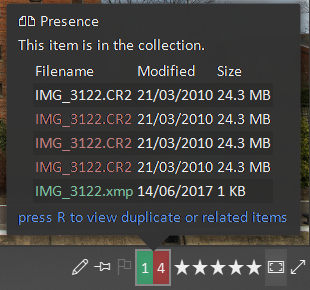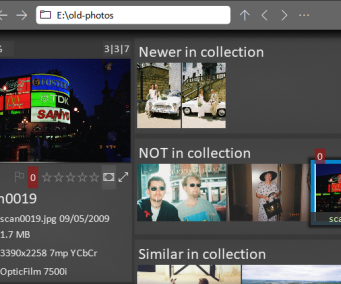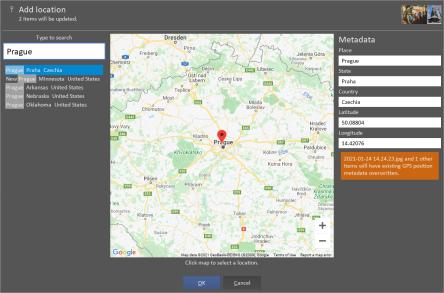Frequently asked questions & reference
What is Diffractor?
Diffractor is a Windows application for organizing, viewing, and searching local photo & video collections. It focuses on fast metadata editing, duplicate detection, and powerful search.
It indexes the collection (one or more folders you choose) to enable fast search, presence (duplicate & sidecar detection), and metadata queries.
Choose / update collection folders in Collection Options (CTRL+F6).
Need a step‑by‑step workflow? See the how‑to guide. This page covers deeper technical details and common questions.
Diffractor can view and play many file formats and codecs. It is not meant to replace a full media player with every playback feature.

- ENTER full screen
- SPACE play / pause video or start slideshow
- ESC exit full screen or dialogs
- LEFT/RIGHT previous / next item
- CTRL+LEFT/RIGHT extend selection for side‑by‑side compare
- F11 toggle fullscreen mode
- K toggle details pane
- CTRL+SPACE zoom to fit
How does Presence & duplicate detection work?
Presence shows whether an item already exists in the collection, has similar / duplicate variants, or has sidecar files (e.g. XMP, subtitles). Hover over a thumbnail to see presence information. Duplicates in red, sidecars in green. Hover over the displayed item title to see presence details.
Duplicate detection compares file metadata and uses perceptual thumbnail fingerprints for visually items. Some duplicates only appear after thumbnails are generated (once viewed or surfaced in search).
Open external folders (e.g. a memory card) and group by presence to identify new items versus those already archived.
Items are grouped into categories:
- Duplicate / similar in collection
- Older / newer version exists
- Not in collection yet


How do I perform advanced searches?

The address bar accepts folder paths, filters, and free‑text. By default only collection folders are searched; add explicit paths to search elsewhere.
Quick search: Press Ctrl+F or F3 to focus search, Ctrl+F3 for advanced search. Use R to search for related files.
The text London can match a tag, description, or location.
Search items can be excluded with a minus. Items not in London -london or Items not in a folder -c:\photos\secret.
Folders & files
Searches can be restricted to a folders by adding a folder to the search text c:\photos c:\videos London. You can search removable media by adding a drive letter (D:) or a volume label (MY-SD-CARD).
D:\Media\2023 limits to a folder. D:\Media\2023\*.jpg limits to JPGs. D:\Media\2023\** flattens subfolders.
Media type filters: @Photo, @Video, @Audio. Combine with OR: @Photo or @Video.
Dates
May = any May. May 2022 = May 2022. 2022 = year. Year:2022 = explicit metadata year (may differ from file create date).
Tags
#London tag match. #London #Fireworks (AND). #London -#Fireworks (exclude). #London or #Paris (OR).
Metadata properties
Exposure:1/60, FNumber:2.8, Camera:'Canon EOS 7D', City:'New York'.
Missing metadata
without:tag, with:location, without:rating.
Duplicates
@duplicates on its own or combined (e.g. @duplicates 2022).
How do locations work?

Add an approximate location (nearest town). Built‑in database enables quick lookup. If GPS is embedded, Diffractor resolves town, city, and country automatically.
- L add location to selection
- F3 search by location name
- Ctrl+Shift+O open containing folder
If missing, an online lookup can suggest alternatives.
Which formats & codecs are supported?
Diffractor supports many photo (including RAW), video, audio formats, plus extras (e.g. D64). Full list: Formats & Codecs wiki.
- Most video formats
- Most photo formats including RAW
- Most audio formats
- D64 disk images
Where is metadata stored?
Metadata (tags, rating, description, location) is written using standard XMP / EXIF / IPTC schemas for interoperability.
A local cache accelerates search; edits are flushed back safely.
JPEG/TIFF/PNG/GIF: embedded EXIF/IPTC/XMP. RAW: typically .XMP sidecar. MOV/MP4/MP3: native atoms+optional XMP. MKV/AVI: XMP (Matroska tags extended later).
Field list: Metadata wiki.
Which operating systems are supported?
Windows 7, 8, 10, 11 (desktop). macOS / Linux not supported currently.
Is Diffractor a media player?
Primarily an organizer & metadata editor; playback is convenient, not exhaustive.
Why did a metadata write fail?
File failed validation (non‑standard or corrupt). Operation aborted to protect file. Report cases via support.
Does Diffractor perform lossless rotations?
Yes—JPEG 90° rotations are lossless.
How do I disable indexing or GPU?
Use -no-indexing or -no-gpu command‑line options.
Access help quickly?
F1 for help, Ctrl+F1 for keyboard shortcuts reference. These are always available.
Does Diffractor respect my privacy?
YES. No personal data collected or uploaded. Diffractor does contact the server to check for updates, this can be disabled in options. It can also upload anonymous diagnostics if Diffractor crashes, this can also be disabled in options.
Compare two photos / videos?
Select an item then CTRL+LEFT/RIGHT to extend selection.
Press A to pin files, making the pinned item stay selected for comparison.
